Note: bash_profile is completely different from configuration profiles. Learn more about Configuration Profiles in my book: ‘Property Lists, Preferences and Profiles for Apple Administrators’ Note:…
Source: About bash_profile and bashrc on macOS – Scripting OS X
Tag: OS X
-
About bash_profile and bashrc on macOS – Scripting OS X
-
Repair / Verify Disk Permissions in OS X El Capitan
$ sudo /usr/libexec/repair_packages --verify --standard-pkgs / $ sudo /usr/libexec/repair_packages --repair --standard-pkgs --volume / -
Signing Git Commits without Entering Password Using `gpg-agent` and `pinentry-mac` on OS X
Install required packages via Homebrew:
$ brew install gpg gpg-agent pinentry-macEdit and add the following lines in
~/.gnupg/gpg-agent.conf:pinentry-program /usr/local/bin/pinentry-macEdit and enable
use-agentin~/.gnupg/gpg.conf:use-agentThen add the following line to your shell profile:
eval $(gpg-agent --daemon --sh) -
ProxyChains-NG and OS X El Capitan System Integrity Protection System Integrity Protection
Apple introduces System Integrity Protection (SIP) as a security feature for OS X El Capitan (10.11), which prevent ProxyChains-NG working as before, you have to disable SIP to make it work:
- Reboot your Mac into Recovery Mode by pressing command-R
- Open Terminal and type
csrutil enable --without debug:
$ csrutil enable --without debug $ csrutil: requesting an unsupported configuration. This is likely to break in the future and leave your machine in an unknown state. $ Successfully enabled System Integrity Protection. Please restart the machine for the changes to take effect.Just ignore the warnings and then restart your Mac.
-
How to Update “Bypass proxy settings for these Hosts & Domains” Programmatically in OS X
You can get all proxy bypass domains using:
$ networksetup -getproxybypassdomains "Wi-Fi"The
Wi-Fishould be your current interface, you can also update it using:$ networksetup -setproxybypassdomains "Wi-Fi" \ *.local \ 0.0.0.0/8 \ 1.0.0.0/9 \ 1.160.0.0/11 \ 1.192.0.0/11 \See
man networksetupfor more information -
Uninstalling letsencrypt – Let’s Encrypt Community Support
If you have the environment variable
XDG_DATA_HOMEset, the installation is located at$XDG_DATA_HOME/letsencrypt. Otherwise, it is located at~/.local/share/letsencrypt. You can simply delete this directory. You can also delete configuration, work, and log directories which by default are stored at/etc/letsencrypt,/var/lib/letsencrypt, and/var/log/letsencryptrespectively. The directory where you cloned our git repo can also be deleted.Let’s Encrypt also installs some OS dependencies and how you remove these would be very OS specific. To see what dependencies were installed, take a look at the files in the bootstrap folder at the root of our git repo (link). Take a look at the shell script for your OS to see what packages are required. You can uninstall these packages through the normal means of your OS, but make sure they aren’t required by any other programs on your system.
Source: Uninstalling letsencrypt – Let’s Encrypt Community Support
-
三星 850 Pro 、 OS X El Capitan 、 SSD Trim 備忘
最近重灌了 El Capitan,在找「三星 850 Pro 是否可以用 trimforce 開啟 Trim 支援」時發現了下面的信息:
- Apple warns users on new Trim support in 10.10.4
- Samsung 850 Pro SSD 256 gb slower after firmware update EXM02B6Q. Original firmware EXM01B6Q worked perfect!
- trim does not work with Samsung 840 EVO after firmware update (EXT0DB6Q)
- Samsung SSD 850Pro firmware update queued TRIM problems
我就看了下我的硬體:
Samsung SSD 850 PRO 512GB: Capacity: 512.11 GB (512,110,190,592 bytes) Model: Samsung SSD 850 PRO 512GB Revision: EXM01B6Q Serial Number: S1SXNSAF806527E Native Command Queuing: Yes Queue Depth: 32 Removable Media: No Detachable Drive: No BSD Name: disk0 Medium Type: Solid State TRIM Support: No Bay Name: Lower Partition Map Type: GPT (GUID Partition Table) S.M.A.R.T. status: Verified😀
-
Export Compact SVG with Sketch
Bohemian Coding – Preferences.
Used to tell Sketch to export compact SVG files. We add some metadata to exported SVG files, to make it easier to re-import them in Sketch. However, if you are sure you won’t import them, you can disable the saving of metadata by running this into your Terminal.app:
$ defaults write com.bohemiancoding.sketch3 exportCompactSVG -bool yesWhen this is set to YES, Sketch will not use the name of the layer for the id field of the layer in SVG export:
$ defaults write com.bohemiancoding.sketch3 svgExportSkipAssignIdToLayerName -bool yes -
How to Use FFmpeg to Extract Audio from Video File Without Re-encoding
Try
-c copy:$ ffmpeg -i video.mp4 -c copy audio.aacHow ever you have to know the original audio format to extract audio without re-encoding, for example:
$ ffmpeg -i video.mp4 ... Metadata: major_brand : isom minor_version : 1 compatible_brands: isomavc1 creation_time : 2015-01-17 20:39:33 Duration: 00:23:59.94, start: 0.000000, bitrate: 1983 kb/s Stream #0:0(und): Video: h264 (High) (avc1 / 0x31637661), yuv420p(tv, bt709), 1280x720 [SAR 1:1 DAR 16:9], 1787 kb/s, 23.98 fps, 23.98 tbr, 24k tbn, 47.95 tbc (default) Metadata: creation_time : 2015-01-17 20:39:33 handler_name : 264:[email protected] Stream #0:1(jpn): Audio: aac (LC) (mp4a / 0x6134706D), 48000 Hz, stereo, fltp, 191 kb/s (default) Metadata: creation_time : 2015-01-17 15:55:11 handler_name : Sound Media Handler ...Then you should know what format and which track to extract.
-
How to Uninstall NoMachine on OS X
After uninstalling the app, you have to remove these shit:
In
/System/Library/Extensions/:- nxaudio.kext
- nxfs.kext
- nxtun.kext
In
/System/Library/StartupItems/:- nxfs/
- nxtun/
In
/private/etc/:- NX/
-
How to Uninstall XQuartz on OS X
From http://xquartz.macosforge.org/trac/ticket/675:
launchctl unload -w /Library/LaunchAgents/org.macosforge.xquartz.startx.plistsudo rm -rf /opt/X11* /Library/Launch*/org.macosforge.xquartz.* /Applications/Utilities/XQuartz.app /private/etc/*paths.d/*XQuartzsudo pkgutil --forget org.macosforge.xquartz.pkg
-
How to Allow Only localhost Access in MAMP Pro
Simply add
127.0.0.1to your MAMP Pro to allow localhost access, if you also want local subnet access, just add10.0.1.0/24(change this according to your local ranges)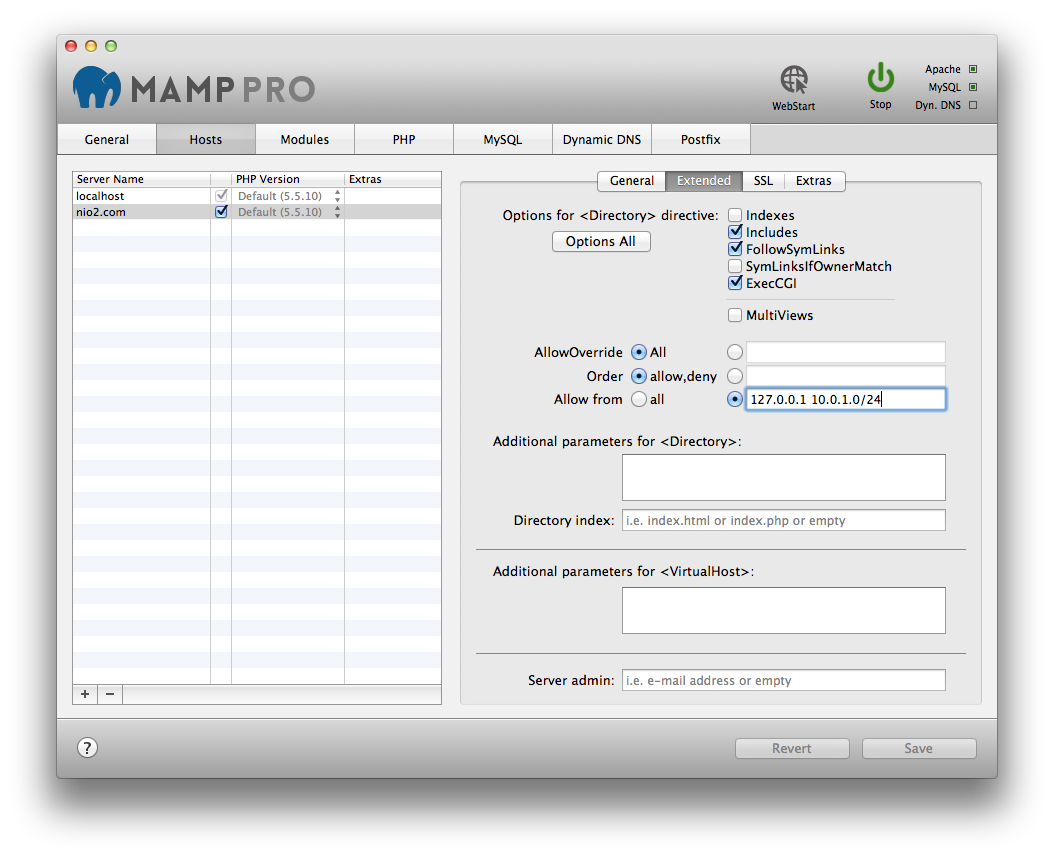
-
Update HP Laserjet Printer Firmware on OS X
If your printer firmware has official OS X version (for example LaserJet Pro MFP M476dn), just download the official DMG update and run it.
If your printer doesn’t have official firmware update for OS X, then you should:
- Download the Windows version firmware (any version should be ok)
- Extract the .exe using 7-Zip, you will get `product-update.acl`, this is the firmware update file
- Open HP Utility (the official HP Printer Software shipped with your pinter)
- On the menu, click “Show Advanced Options”, then you will see a “Update Firmware” icon
- Click it and choose the `product-update.acl` we just extracted from the package, then click “Update”
Then your printer status will be “Printing”, during update your printer will get disconnected for 1-2 minute(s), then it will be back to normal and shown as “Ready” on your printer LED display.
If you don’t like HP softwares and you don’t have it on your OS X, you can also update it with the following steps:
- Download Windows version firmware, extract it, the same as the “HP Utility” method
- Open Terminal, type
lpr ~/Downloads/product-update.acl(change the path to your real location)
Please note you have to set the printer you want to update as default printer, or you have to specify the printer with
lprorlp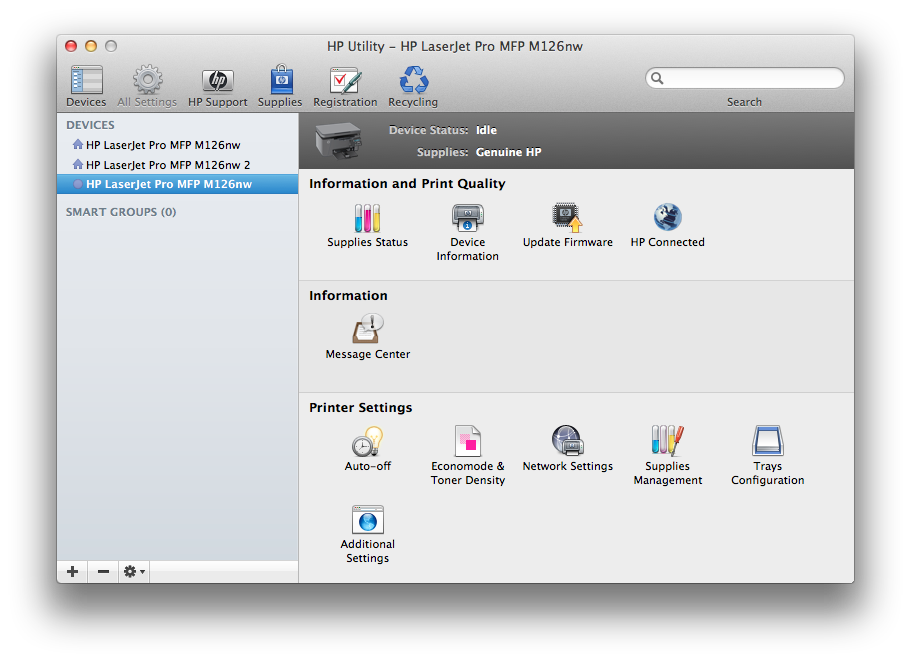
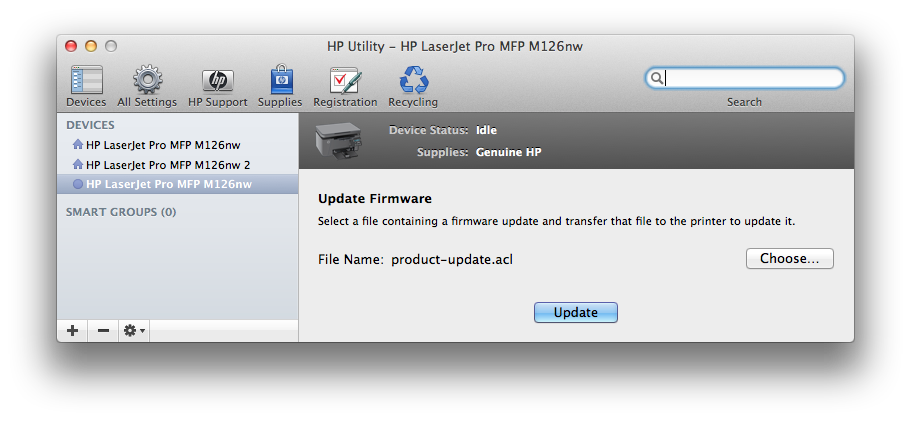
-
How to Setup Gmail (Google Apps) Mail Account with Apple Mail
- Open Gmail settings, switch to Labels tab
- Check Sent Mail, Drafts, Spam, and Trash
- Uncheck all others
- On OS X, configure mailbox behaviors as the following screenshot:
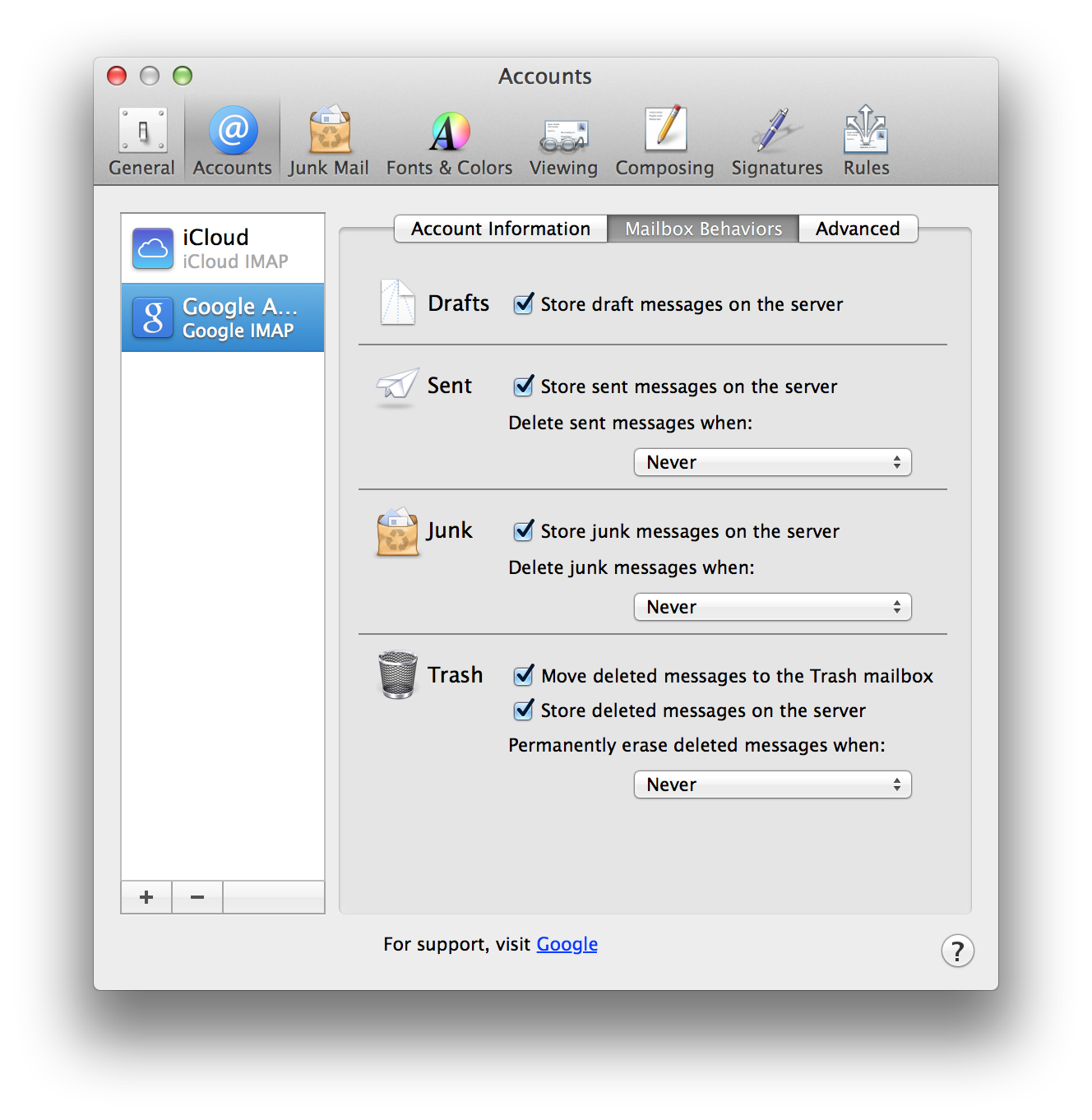
Reference: Using Gmail with Apple Mail
-
How to Move Plex Media Cache to External Hard Drive
$ cp -pr ~/Library/Application\ Support/Plex\ Media\ Server/Media /Volumes/Backups\ HD/Temporary\ Files/Plex\ Media\ Cache $ ln -s /Volumes/Backups\ HD/Temporary\ Files/Plex\ Media\ Cache/Media ~/Library/Application\ Support/Plex\ Media\ Server/MediaPlatform: OS X
-
Export Website RSA Private Key for Apache Server Certificate from OS X Server
If you’re using OS X Server and MAMP Pro at the same time, and you’d like to export OS X site certificates to use them for MAMP Pro sites, you can do the following:
- Locate certificate (Category -> Certificates)
- control + click -> Export… -> Certificate.p12
Next, I need to split the PKCS12 archive, to get the old private key out:
$ openssl pkcs12 -in site.p12 -nocerts -out site.keyRemove passphrase from the key (otherwise you have to enter it lots when you restart services.)
$ openssl rsa -in site.key -out site.unprotected.keyRead more: Renewing a SSL Certificate on OSX Server
-
Fix RubyGems Postinstall Error
gem pristine --all --only-executables -
Using S/MIME With Apple Mail
- What Is S/MIME Email and Why Should I Be Using It
- S/MIME Email Certificates in-Depth
- Using S/MIME With Apple Mail
Free email certificate can be found at COMODO
-
How to Cleanup Systems w/o CleanMyMac (a.k.a. OS X Cleanup Guide)
Here’re some folders you should check if you want to cleanup your Mac, all the following folders are also frequently scanned by CleanMyMac. Check and remember these then you won’t need CleanMyMac anymore.
Cache Files
All cache files can be deleted, but there’s no need to remove them too often, Homebrew uses the system cache folder to cache libraries.
/Library/Caches/ ~/Library/Caches/Logs
All logs can be deleted safely.
/Library/Logs/ ~/Library/Logs/Internet Plugins
Some of them are default from OS X. Check the bundle
.plistto see if they’re shipped by default. In most cases, your user plugins folder shouldn’t be existed, most of them in this folder can be safely removed.AdobeAAMDetect.pluginis stored in system plugins forder./Library/Internet Plug-Ins/ ~/Library/Internet Plug-Ins/Launch Agents
All files in these folders are safe to delete. I have
com.adobe.AAM.Updater-1.0.plistandcom.adobe.AdobeCreativeCloud.pliststored in the system launch agents folder, they can be safely deleted./Library/LaunchAgents/ ~/Library/LaunchAgents/Launch Daemons
Some apps stored their daemons app here, such as Clean My Mac and Textmate. They’re safe to delete. There’s no user launch daemons folder by default.
/Library/LaunchDaemonsPrivileged Helper Tools
Some apps uses privileged helpers to gain more access across different users from your Mac. For example I have
com.macpaw.CleanMyMac2.Agentandcom.macromates.auth_serverin the following folder./Library/PrivilegedHelperToolsQuickLook Plugins
There’re two default plugins related to iBooks Author and iWork in system QuickLook folder, my user QuickLook folder is empty.
/Library/QuickLook/ ~/Library/QuickLook/Spotlight Plugins
There’re iBooks Author and iWork plugins, too, plus a Microsoft Office Spotlight plugin shipped with OS X (10.9). My user Spotlight folder is empty.
/Library/Spotlight/ ~/Library/Spotlight/ -
Hama (HTTP Anidb Metadata Agent) and Plex Media Server
最近發現一個比 AniDB agent 還好用的 Plex agent:Hama (HTTP Anidb Metadata Agent),效果非常不錯,支持 AniDB 和 TVDB 抓取 banner 、 background 、 theme song,可以更好的識別日文文件夾的結構,更新後再也不用在 Plex 里看羅馬音了
-
How to Configure Multiple DNS Redirections (PlexConnect-like Service) for Apple TV
目標
- Apple TV 通過修改 DNS,可以觀看 享看
- 同時也可以通過本地架設 Plex+PlexConnect 來觀看 Plex
難點
- 「享看」官方的 DNS 和 PlexConnect 都默認劫持 Apple TV 中的 Trailers 頻道,同時使用會造成衝突
- OS X Server 在 Mavericks 中對 HTTP 的 80 端口享有絕對控制權,而 PlexConnect 需要獨佔 80 端口
實現方法
- 在 OS X Server 上安裝 Plex 、 PlexConnect 和 Dnsmasq
- 通過在 OS X Server 上創建新介面,設置額外 IP,避免 PlexConnect 80 端口衝突
- 本地架設 Dnsmasq,同時劫持 Apple TV 上兩個不同頻道來實現「享看」和 PlexConnect 共存
配料表
- 裝有 OS X 的電腦一部
- Apple TV 一部
- Plex 一只
- PlexConnect 一只
- Dnsmasq 一只
網絡基本結構設置
10.0.1.3:OS X Server,DHCP with manual address(或通過 MAC 地址綁定亦可,主要是需要保持主 IP 固定)10.0.1.4:OS X Server,額外 IP(PlexConnect),DHCP with manual address
為 OS X Server 設置額外 IP
由於 OS X 上已經安裝過 Server app,為了避免與系統的 80 端口衝突,我們必須將 PlexConnect 的 80 端口指向額外的 IP 。首先我們 duplicate 現有的網絡(或者直接創建新介面),Wi-Fi 、以太均可,為了區分,可以將此服務命名為「PlexConnect」,IP 獲取方法為 DHCP with manual address,地址為
10.0.1.4(具體情況請根據自己的路由分配狀況自行修改),然後將 DNS 設置為10.0.1.3,即 Dnsmasq 所在的主 IP,Dnsmasq 的相關設置我們會在接下來講,其他設置保持默認Dnsmasq 安裝與配置
推薦的方法是通過 Homebrew 安裝:
brew install dnsmasq哦?想自己編譯源代碼安裝?那請跳過此步驟
然後我們需要
vi /usr/local/etc/dnsmasq.conf來修改 Dnsmasq 的配置,Dnsmasq 的默認配置是無法作為 DNS server 使用的,以下是必備的配置:https://gist.github.com/9fea03b8e6349ab3c805
port=53:DNS 默認端口,這裡我們需要禁用 Server app 里的 DNSdomain-needed:不轉發 plain namebogus-priv:不轉發本地的nslookup請求server=8.8.8.8和server=8.8.4.4:使用 Google 的 DNS 作為主、從 DNS,當然也可以選擇 ISP 提供的local=/localnet/:讓本地域名走/etc/hosts或者 DHCPaddress=/trailers.apple.com/180.153.225.136:享看 DNS,劫持 Apple TV 中的 Trailers,具體的 IP 地址請去享看官網參考address=/secure.marketwatch.com/10.0.1.4:PlexConnect DNS,劫持的是 WSJ,指向的是本地的 PlexConnect instancelisten-address:限制 Dnsmasq listen 指定地址,當然也可以按interface來限制
以上就是本教程的技巧所在,運用 Dnsmasq 對不同域名進行劫持,來實現「享看」和 PlexConnect 的共存,通過下面的方法可以測試是否設置正確:
dig trailers.apple.com @10.0.1.3 dig secure.marketwatch.com @10.0.1.3執行下面命令可以啓動、停止 Dnsmasq
sudo launchctl stop homebrew.mxcl.dnsmasq sudo launchctl start homebrew.mxcl.dnsmasqPlexConnect 的安裝與配置
PlexConnect 官方提供有 詳細的教程,具體請參考官方的方法。在這裡我只對配置文件做詳細描述:
配置方面,為了避免與 Server app 的
httpd衝突,我們要將 PlexConnect 的 server 綁定到之前設置的10.0.1.4上,另外我們也自己搭建了 Dnsmasq,需要把 PlexConnect 自帶的 DNS 服務禁用,於是我們的 PlexConnect 配置如下:https://gist.github.com/cb1e7dee359fe3d9b8a1
以下是必備的設置:
enable_plexconnect_autodetect = False:因為我們有多 IP,避免造成混亂,我們把 Plex server 的 auto detect 禁用掉ip_pms = 10.0.1.3:既然禁用了,我就需要指定 Plex 的 IPport_pms = 32400:相應的端口,我是用的默認端口ip_plexconnect = 10.0.1.4:指定 PlexConnect 的 IP 地址,這裡用我們創建的新 IPenable_dnsserver = False:這裡禁用自帶 DNSip_dnsmaster = 10.0.1.3:使用我們自己的 Dnsmasqhosttointercept = secure.marketwatch.com:設置要劫持的域名,這裡要與 Dnsmasq 中的設置保持一致
測試
當以上都設置好後,確認 Dnsmasq 、 PlexConnect 均已運行,在瀏覽器中打開
http://10.0.1.3/,應該可以返回httpd的網站;打開http://10.0.1.4/則是返回「Error response」,一個code 403的頁面,這時就是配置正確了Apple TV 證書設置
測試都沒甚麼問題後,可以開始搞 Apple TV 的證書了,Apple TV 從某一版本更新後,所有的連接都走 HTTPS 了,這時候我們如果直接劫持就不會奏效,於是我們需要使用自己的證書並上傳到 Apple TV,讓 Apple TV 認為我們的劫持的內容才是真正的網站內容
設置方法比較簡單,可以通過 USB 線與 Apple TV 連接傳輸,也可以通過直接在 Apple TV 中直接添加,具體方法請參考 PlexConnect 文檔,需要注意的是,因為我們劫持了兩個頻道,所以兩個頻道的證書都需要進行 hack 並通過 profile 上傳到 Apple TV 中
證書設置好了,接下來就可以在 Apple TV 上進行測試了,將 Apple TV 的 DNS 改為
10.0.1.3,然後回到主屏分別進入 Trailers 和 WSJ 測試即可更多設置
- 你可以設置讓 Dnsmasq 開機時自動加載,設置方法可以參考
brew info dnsmasq - 你也可以設置讓 PlexConnect 開機是自動加載,設置方法請參考 官方文檔
- 如果你也有使用 Server app 自帶的 DNS,可以有多種方案,一是全轉移到 Dnsmasq(推薦);或者保持
named和dnsmasq共存,但這時需要設置named只監聽10.0.1.3;再或者全部轉移到自帶 DNS 服務,如果是後兩者,這篇文章 可能會幫到你 - 如果你 Server app 中的
httpd沒跑任何服務,也可以通過 配置反向代理 來將系統的 web 服務轉向 PlexConnect 的內容
-
FlexGet + Transmission + Plex AniDB Agent on macOS
目標
- 自動下載新番種子
- 種子自動加入 Transmission 下載隊列
- 新番文件自動重命名到 Plex 兼容格式
- 通過 Plex AniDB agent 自動獲取新番相關信息
總結:基於 FlexGet 和 Transmission 的全自動追番方案
實現方法
- 通過 FlexGet 讀取 RSS,自動下載種子文件,通過正則自動剔除無效字符
- 通過 FlexGet 的 transmissionrpc 插件自動將種子傳送到 Transmission
- Transmission 下載完成後觸發腳本,自動將種子重命名為 Plex 可識別格式
- 通過 Plex 的第三方插件 Hama.bundle 自動獲取新番相關訊息
配料表
- 裝有 macOS 的電腦一部
- Plex
- Transmission
- FlexGet
配置 FlexGet(2021 版)
最新版本配置採用 FlexGet 內置的 manipulate 方法,對 RSS 直接修改為符合 Plex 查詢標準的文件名,避免了使用 Transmission 調用外掛腳本的方案,下面的正則可根據實際場景進行修改:
bangumi: template: torrent manipulate: - title: # remove underscores replace: regexp: '_' format: '' - title: replace: regexp: '★' format: '' - title: extract: '^[\[【].*?[\]】](.*)' - title: replace: regexp: '【' format: '[' - title: replace: regexp: '】' format: ']' - title: replace: regexp: '】' format: ']' - title: replace: regexp: '(?:\[|【)(简体|簡體|繁体|繁體|简日双语|繁日雙語|GB|BIG5|MP4)(?:\]|】)' format: '' - title: replace: regexp: '(?:\[|【|第)(\d\d)(?:\]|】|話|话)' # format: 's01e\1' format: '\1' - title: # replace `][` to ` ` (space) replace: regexp: '\]\[' format: ' ' - title: # remove leftover brackets replace: regexp: '[\[\]【】]' format: ' ' - title: replace: regexp: '(?:.*字幕 (?: 组|組))' format: '' - title: replace: regexp: '\[(?:.+? 月新? 番)' format: '' set: path: /Volumes/Gizur/Downloads/Anime/{{ series_name }} content_filename: '{{ series_name }} - {{ series_id|pad(2) }}' magnetization_timeout: 45 series: - スーパーカブ: alternate_name: 本田小狼與我 Super Cub - ダイナ莊びより: alternate_name: 恐龍日和 - 回復術士のやり直し 〜即死魔法とスキルコピーの超越ヒール〜:配置 FlexGet(2013 版,無需再看)
FlexGet 的安裝方法和自動運行請參考參考 官方文檔,寫的很詳細
配置文件如下,要點在於
presets.global.transmission.path,為了能讓 Plex 識別和方便管理,每一個動畫 要分別放在相應命名的目錄。其中{{task}}對應的就是tasks下的新番標題:presets: global: accept_all: true transmission: host: localhost port: 9091 addpaused: No ratio: 0.01 removewhendone: Yes path: "/Volumes/Backups HD/Anime/{{task}}/" tasks: WHITE ALBUM2: rss: http://bt.ktxp.com/rss-search-%E6%BE%84%E7%A9%BA%E5%AD%A6%E5%9B%AD+%E7%99%BD%E8%89%B2%E7%9B%B8%E7%B0%BF+2+MP4+720p.xml アウトブレイク・カンパニー: rss: http://bt.ktxp.com/rss-search-%E6%BE%84%E7%A9%BA%E5%AD%A6%E5%9B%AD+%E8%90%8C%E8%90%8C%E4%BE%B5%E7%95%A5%E8%80%85+MP4+720p.xml ガリレイドンナ: rss: http://bt.ktxp.com/rss-search-%E6%BE%84%E7%A9%BA%E5%AD%A6%E5%9B%AD+%E4%BC%BD%E5%88%A9%E7%95%A5%E5%B0%91%E5%A5%B3+%E7%AE%80%E4%BD%93+MP4+720p.xml キルラキル: rss: http://bt.ktxp.com/rss-search-%E6%A5%B5%E5%BD%B1%E5%AD%97%E5%B9%95%E7%A4%BE+Kill+La+Kill+BIG5+MP4+720p.xml 京騒戯画: rss: http://bt.ktxp.com/rss-search-WOLF+%E4%BA%AC%E9%AA%9A%E6%88%8F%E7%94%BB+GB+720P+MP4.xml 凪のあすから: rss: http://bt.ktxp.com/rss-search-%E5%8B%95%E6%BC%AB%E5%9C%8B+%E4%BE%86%E8%87%AA%E9%A2%A8%E5%B9%B3%E6%B5%AA%E9%9D%9C%E7%9A%84%E6%98%8E%E5%A4%A9+720P+%E7%B9%81%E9%AB%94+MP4.xml 境界の彼方: rss: http://bt.ktxp.com/rss-search-%E6%BE%84%E7%A9%BA%E5%AD%A6%E5%9B%AD+%E5%A2%83%E7%95%8C%E7%9A%84%E5%BD%BC%E6%96%B9+%E7%AE%80%E4%BD%93+MP4+720p.xml 夜桜四重奏 ~ハナノウタ~: rss: http://bt.ktxp.com/rss-search-%E6%A5%B5%E5%BD%B1%E5%AD%97%E5%B9%95%E7%A4%BE+%E5%A4%9C%E6%AB%BB%E5%9B%9B%E9%87%8D%E5%A5%配置 Transmission
如果使用了 2021 版的方案,請略過本段
Transmission 本身不需要進行過多配置,為了避免下載隊列越來越多,記得勾選下載完成後從隊列刪除這個選項。下面是其對應的 post-process 腳本:
#!/bin/sh # Search all subdirectories # Use rename -n for dry-run cd /Volumes/Backups\ HD/Anime find . -name '*.mp4' -print0 | xargs -0 /usr/local/bin/rename -f 's/\[(.*)\]\[(.*)\]\[(\d{2})\].*$/$2 - $3\.mp4/'上述腳本會通過正則將
[Fansub][Title][Episode]*.mp4這樣的格式替換為 Plex 可識別的Title - Episode.mp4格式,例如[WOLF&HYSUB][Kyousougiga][00][GB][720P][MP4].mp4就會被替換為Kyousougiga - 00.mp4配置 Plex w/ Hama Agent
注意!,已棄用 AniDB agent,改為 Hama Agent 。詳情請訪問最新文章:Hama (HTTP Anidb Metadata Agent) and Plex Media Server – 2014-04-09
訪問 Plex 論壇 下載 AniDB agent 并安裝,通過 Plex 的 web 界面進行管理即可
完成配置後可通過下列指令進行 dry run 測試:
flexget -c ~/.flexget/config.yml --test execute以下是效果圖:

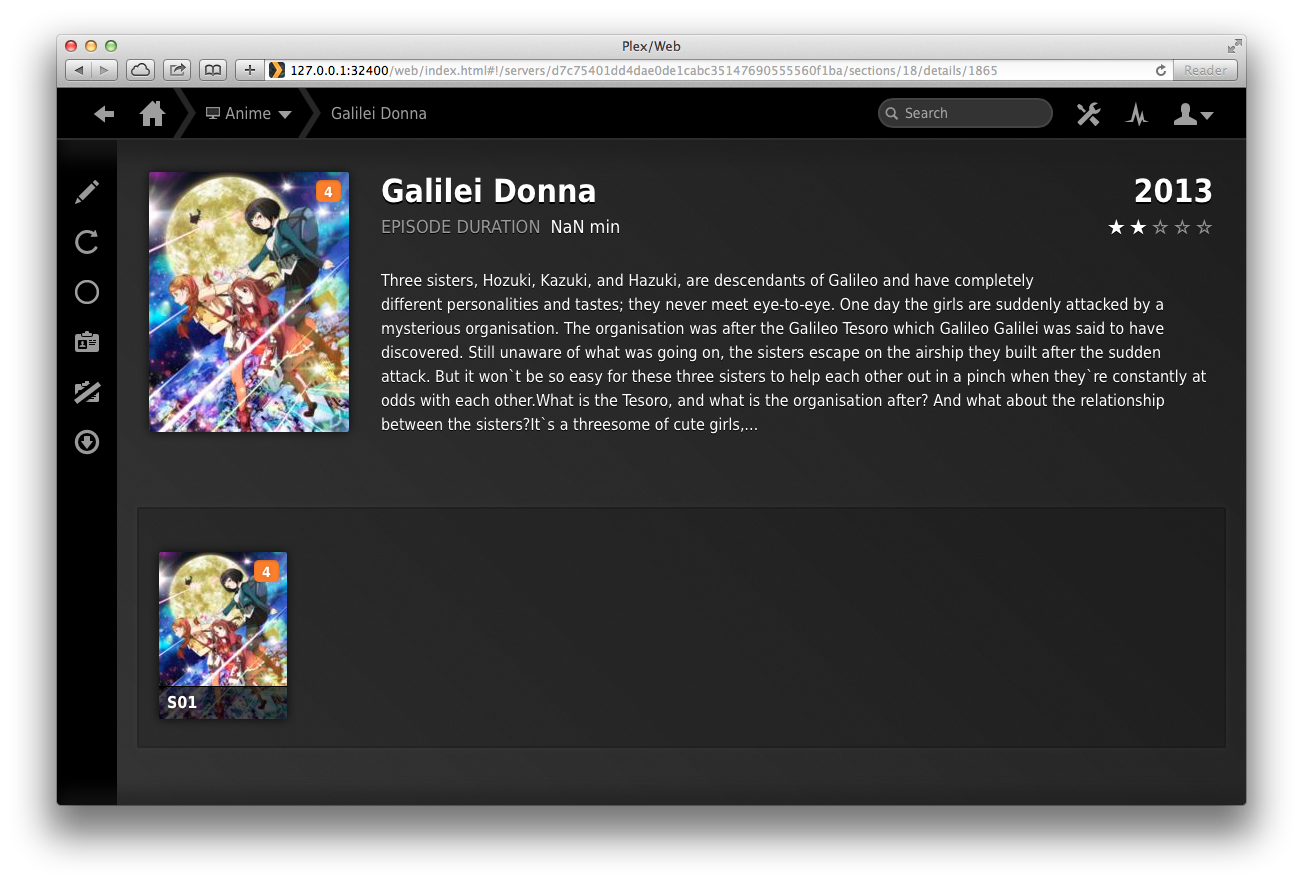

-
How to Batch Delete PNG Screenshots in iPhoto
输入下列命令,替换其中的路径即可:
find /Volumes/Remote HD/Pictures/username/iPhoto Library/Masters/ -name '*.PNG' -type f
注意以上命令不会删除图片,只会将其显示,如需删除,需要在最后添加
-delete选项,即:find /Volumes/Remote HD/Pictures/username/iPhoto Library/Masters/ -name '*.PNG' -type f -delete
注意!此方法删除不可逆,图片不会进入垃圾桶,而是直接删除。另外此方法同样适用于「批量删除所有 MOV 视频」
-
Fix “The folder “Backups.backupdb” can’t be opened because you don’t have permission to see its contents.” Error
According to this site, you can simply use the following command:
sudo chmod -RN /path/to/your/backup/
But note that it may taks very long to remove all ACL attributes.
If the method mentioned above didn’t work, you may also try this one:
You could also invoke “Enter Time Machine” as root. That requires Finder to be started as root first, so only for those who understand the risks. In Terminal, for both Leopard and Snow Leopard:
sudo /System/Library/CoreServices/Finder.app/Contents/MacOS/FinderIn Snow Leopard this does not (always?) open an initial Finder window. Do not click the Finder icon in the Dock (which might take you to your normal Finder), but use Command-Tab to go to Finder (which will be the new root-Finder). Here, hit Cmd-N for a new Finder window.
The new Finder looks like a normal Finder, but you’ll notice root next to the home folder icon in Finder’s sidebar. While the root-Finder is active, enter Time Machine (and once again validate that root is shown next to the home folder icon). This should allow you to browse, delete or restore what you need (but, for the original question: it won’t solve your access issues permanently).
(As usual, holding down Option while clicking the Time Machine icon will change “Enter Time Machine” into “Browse Other Time Machine Disks” if you need to examine a disk that is not associated to your current machine. You might not need to be running as root to do that though!)
When done, eject the Time Machine volume if applicable. Next, hit Ctrl-C in Terminal to stop the root-Finder. The usual Finder will still be running, but in Snow Leopard the indicator in the Dock may have gone. Run
killal Finderif that bothers you. (And if you forgot to eject the Time Machine volume while you were still root and the disk doesn’t unmount properly at a later time, or if Time Machine won’t mount it correctly when running its hourly backup, then you may simply log off as an easy fix.)(If anyone knows how to do this without first running a root-Finder then please tell us! Running
sudo "/Applications/Time Machine.app/Contents/MacOS/Time Machine"does not give the expected result, and I assume that the Time Machine galaxy window is in fact part of Finder. For the sake of search engines: “run time machine as root”, “start time machine as root”.)This method is tested and also works fine in Mountain Lion.
-
警惕 Mac App Store 上的 QQ for Mac 2.3.0 更新
此次 2.3.0 的更新有如下内容:
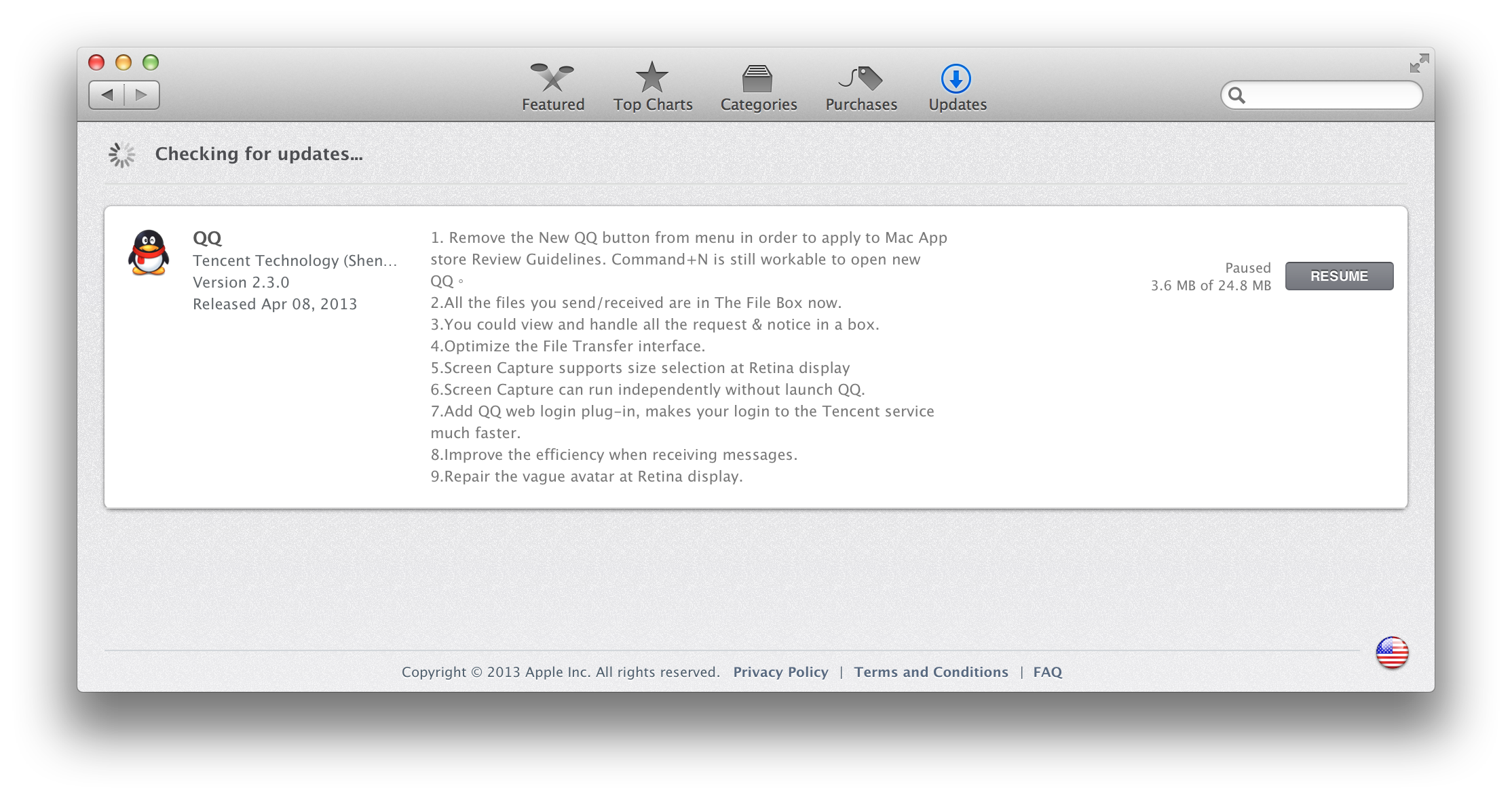
中文:
- 因为 apple 审核规则限制,我们取消了菜单栏的新建 qq 按钮,仅支持 command+n 快捷键新建 QQ.
- 新增文件盒子功能
- 新增请求与通知集成面板
- 传文件面板界面优化
- Retina 下截图支持尺寸选择
- 截图功能可独立使用
- 新增快速登录插件,支持快速登录腾讯服务
- 修复了提取消息卡顿的问题
- 修复了 Retina 下头像模糊的问题
「支持 command+n 快捷键新建 QQ」,是不是感觉很牛屄?「新增快速登录插件,支持快速登录腾讯服务」屌爆了有没有?第一次运行后,有如下提示:
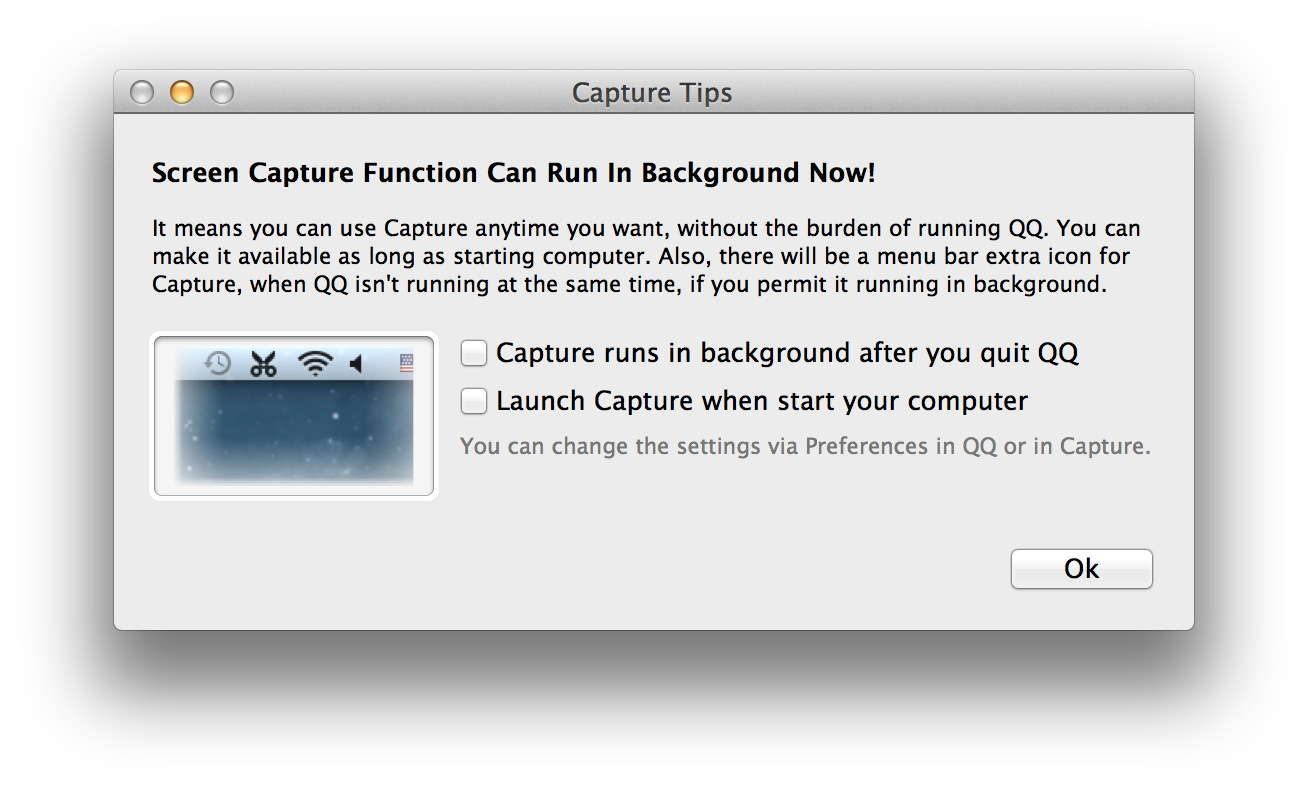
当然是全部取消勾选,然后通过 CleanMyMac 2 的检测,我们发现有一个 QQ Login Item:
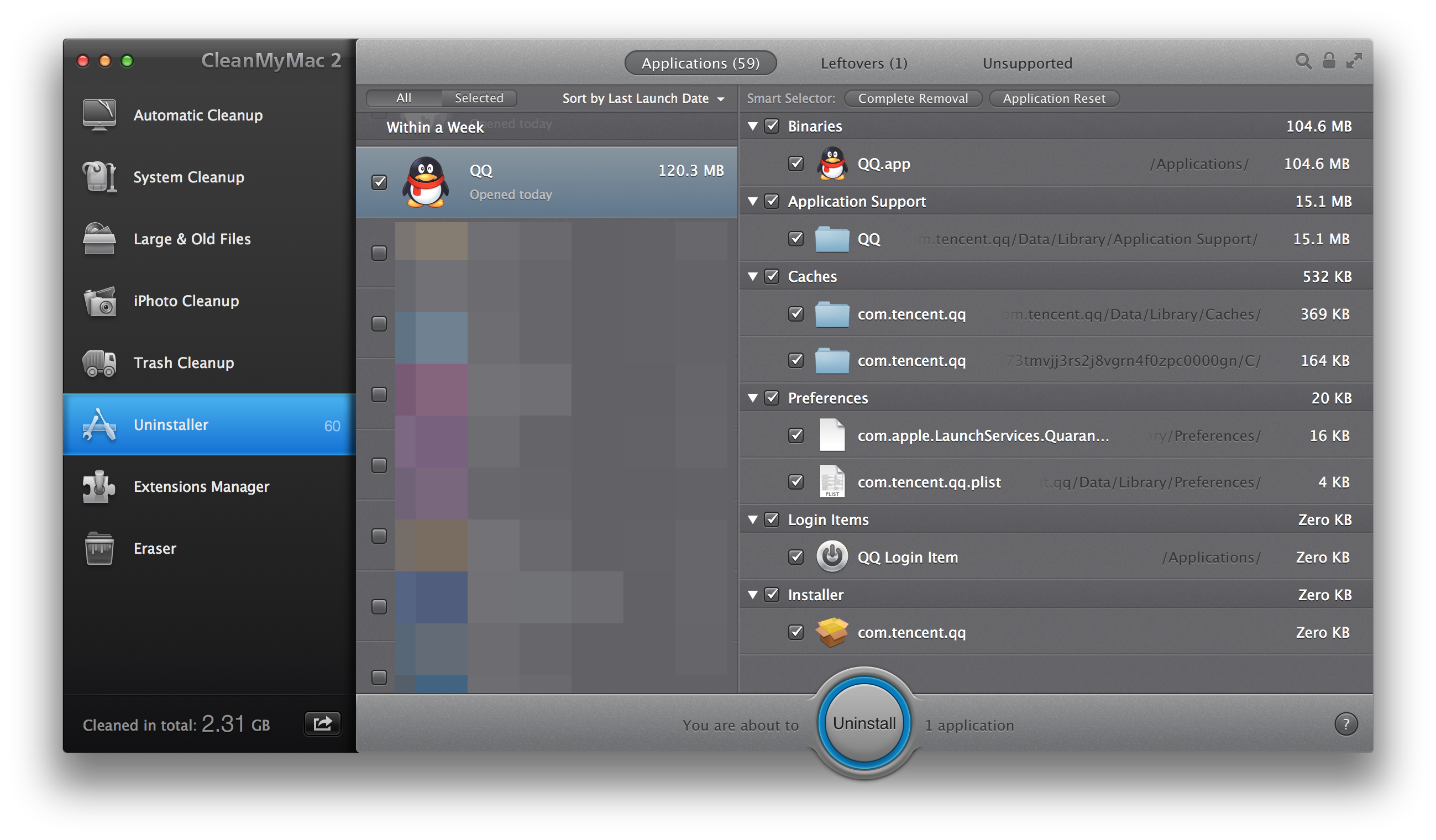
厉害的是系统中并没有这个:
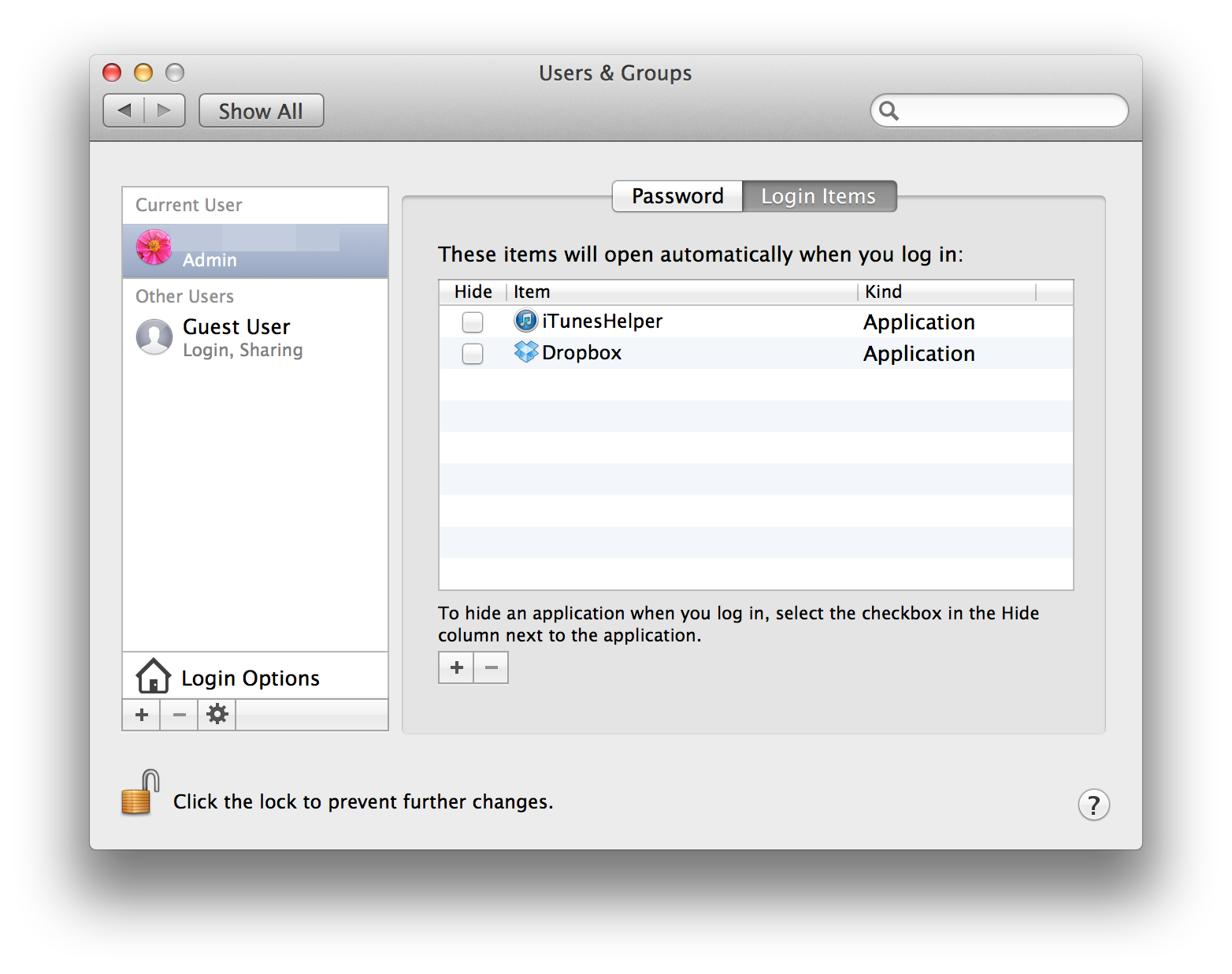
通过查看 launchctl 的手册我们可以发现,一般开机运行有以下几处:
~/Library/LaunchAgentsPer-user agents provided by the user./Library/LaunchAgentsPer-user agents provided by the administrator./Library/LaunchDaemonsSystem wide daemons provided by the administrator./System/Library/LaunchAgentsOS X Per-user agents./System/Library/LaunchDaemonsOS X System wide daemons.
但在上述目录中完全找不到 QQ 的影子,我们也懒得一点点查了,总之很厉害有没有?
然后我们接着打开系统防火墙,发现了奇怪的东西:
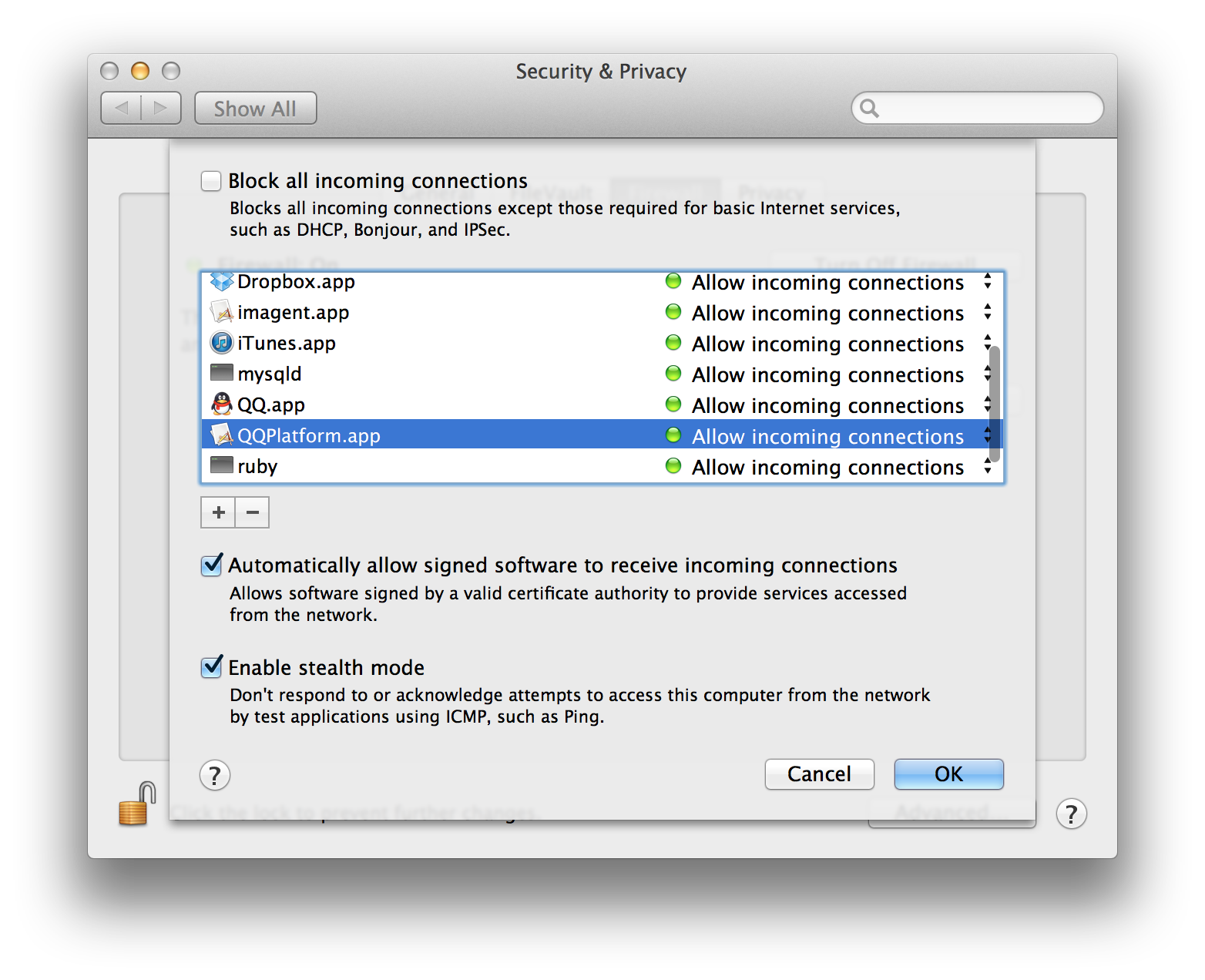
QQPlatform.app 是什么?通过搜索 QQPlatform,我们发现这玩意好像并不是什么好东西,被 多个网站 定义为 Trojan.agent 和 Trojan-Downloader.agent 木马,具体那东西做了啥我们也懒得开 Charles 一点点抓了,总之把 conn 给 block 掉
另外值得一提的是之前提到的「新增快速登录插件,支持快速登录腾讯服务」,是需要去腾讯官网下载的,Sandbox 立功了:
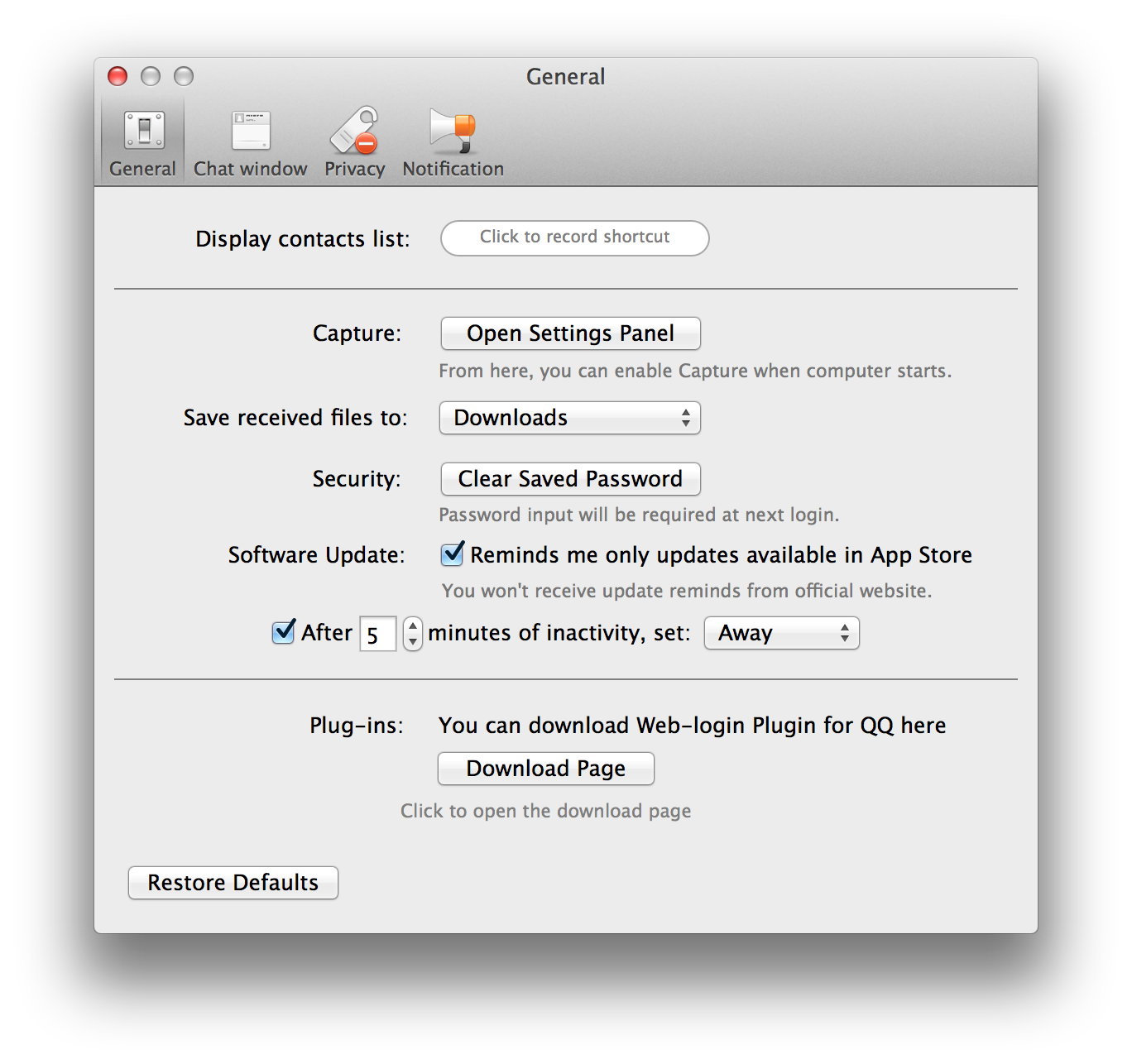
经过以上分析,我们能得出以下结论:
- 一定要开防火墙
- OS X 上最好不要安装中国 app,随着 Mac 的越来越流行,国内的大老板们肯定会盯上这块肉
- 有 Mac App Store 的版本不要用官网下载的版本
- 如果必须要装,请不要在主力机上装,比如我们就装在 Mac mini with OS X Server 上,要用的时候通过 VNC 来使用
-
New Mac Checklist – mactips – Helpful configuration tips for OS X users
This checklist is mainly aimed at setting up a new Mac laptop, with OS X 10.8 (Mountain Lion) pre-installed. Some notes regarding modifications to this procedure for Mountain Lion desktops, or computers that have been upgraded to Mountain Lion from a previous version of OS X, are included. This procedure is what I do – you might find all, some, or none of it useful for your own particular requirements and preferences. The procedure for setting up an OS X 10.7 (Lion) computer is not substantially different.
via New Mac Checklist – mactips – Helpful configuration tips for OS X users.
-
Java SE 6 Locations
The location of the Java SE 6 runtime home has changed to
/System/Library/Java/JavaVirtualMachines/1.6.0.jdk/Contents/Home. JDK bundles provided via the Developer package, developer previews, and 3rd party JVMs should be installed in/Library/Java/JavaVirtualMachinesor~/Library/Java/JavaVirtualMachines. Developer previews of Java can now be installed and uninstalled without affecting the system JVM(s). -
compiler errors – Cannot compile ruby 1.9.3 – Stack Overflow
With Xcode 4.6 I was also getting this problem. I installed the command line tools which made gcc available in /usr/bin/gcc.
I managed to get it to work using:
rvm install 1.9.3 --with-gcc=gcc
NB. I dont have homebrew installed.
via compiler errors – Cannot compile ruby 1.9.3 – Stack Overflow.
-
Things You Need To Do Before You Reinstall Adobe Photoshop
- Brushes
- Actions
- Textures
- Gradients
- Keyboard Shortcuts
- Color Scheme
- Plug-Ins (/Applications/Adobe Photoshop CS6/Plug-ins)
- Scripts (/Applications/Adobe Photoshop CS6/Presets/Scripts)
-
Connecting to MAMP sites from other local network clients | Raygun
The solution is to create a local proxy server on the machine that has MAMP installed, and then configure the client to use that proxy to browse the web. The client configuration only takes a few seconds, and is easy to disable once you’re done.
via Connecting to MAMP sites from other local network clients | Raygun.
-
Installing the Old AirPort Utility (Version 5.6) on Mountain Lion | frank.is
As it turns out, the AirPort Utility application is totally compatible with Mountain Lion even though its installer isn’t. Using it is a not-so-simple process of extracting it from the package.
via Installing the Old AirPort Utility (Version 5.6) on Mountain Lion | frank.is.
-
当在 OS X 上编译部署 Ruby 时出现 “You have to install development tools first.” 错误时的解决方案
一般出现这个问题时在 Lion 、 Mt. Lion 往上的系统中,因为自从某个版本之后 Xcode 将 gcc 由
gcc-4.2改为llvm-gcc-4.2所致。所以解决方法也很简单:cd /usr/bin/ sudo ln -s llvm-gcc-4.2 gcc-4.2
-
Textmate 2.0.0-alpha.9317 Adds Support For Removing Trailing Spaces in Document / Selection
更新摘要:
2012-09-29 (r9317)
New semantic class: callback.document.will-save. This can be used to have a command called prior to saving a document, the command could e.g. strip trailing whitespace or ensure the document has a LF character on last line. Two minor issues is that selection is currently lost after running a “did save” command (when it replaces entire document) and caret is scrolled into the visible area.相关 bundle 设置:
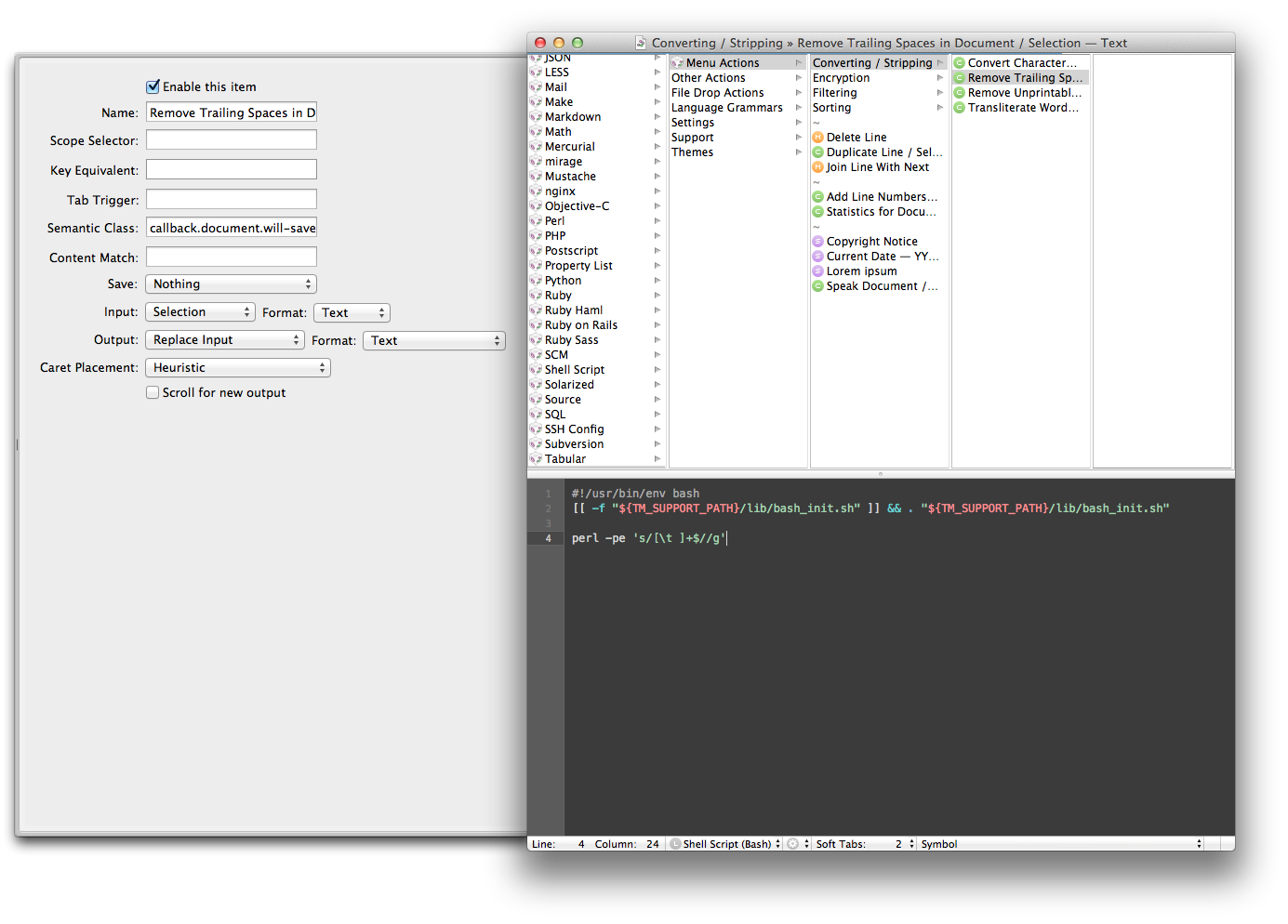
-
Lion 升级至 Mountain Lion,导入 Lion 用户数据后可能会出现的问题
- Mail 中的 RSS 订阅会丢失(解决方案)
- Mail 中的 Rules 会丢失
- Xcode 需要升级
- Xcode 中的 Command Line Tools 、 iOS 5.0 Simulator 需要重新安装
- FaceTime 需要重新激活
- homebrew 需要在安装完 Command Line Tools 之后升级
- s3cmd 需要重新安装
- Dropbox 需要升级
- Keychain Access 需要整理
- Font Book 中的自定义字体会全部 disabled,需要重新启用
- 部分网络连接要在设置中重新设置,以记住密码
-
如何在 Mountain Lion 导出之前 Mail.app 中的 RSS 订阅
cd ~/Library/Mail/V2/RSS/ find . -name "Info.plist" -exec grep -A 1 Feed {} \; | grep string | sed 's/^[^>]*>//' | sed 's/]*>$//' -
让 Mac OS X 上的 Mail 总是自动添加 Reply-To 的方法
- 打开 Terminal
- 输入
defaults read com.apple.mail UserHeaders,回车 - 显示有
The domain/default pair of (com.apple.mail, UserHeaders) does not exist - 输入
defaults write com.apple.mail UserHeaders '{"Reply-To" = "reply-to@address"; }' - 禁用此功能
defaults delete com.apple.mail UserHeaders
注意:此设置会忽略 GUI 中的 Reply-To 设置
-
Install s3cmd beta / alpha on OS X
Beta released: 1.1.0-beta2, now supports invalidation
sudo python setup.py install --record install.log
[10:46:27]humanerrorprocessor@hep: /Users/humanerrorprocessor/Git/s3cmd$ sudo python setup.py install Password: Using xml.etree.ElementTree for XML processing running install running build running build_py creating build creating build/lib creating build/lib/S3 copying S3/__init__.py -> build/lib/S3 copying S3/AccessLog.py -> build/lib/S3 copying S3/ACL.py -> build/lib/S3 copying S3/BidirMap.py -> build/lib/S3 copying S3/CloudFront.py -> build/lib/S3 copying S3/Config.py -> build/lib/S3 copying S3/ConnMan.py -> build/lib/S3 copying S3/Exceptions.py -> build/lib/S3 copying S3/FileDict.py -> build/lib/S3 copying S3/FileLists.py -> build/lib/S3 copying S3/HashCache.py -> build/lib/S3 copying S3/MultiPart.py -> build/lib/S3 copying S3/PkgInfo.py -> build/lib/S3 copying S3/Progress.py -> build/lib/S3 copying S3/S3.py -> build/lib/S3 copying S3/S3Uri.py -> build/lib/S3 copying S3/SimpleDB.py -> build/lib/S3 copying S3/SortedDict.py -> build/lib/S3 copying S3/Utils.py -> build/lib/S3 running build_scripts creating build/scripts-2.7 copying and adjusting s3cmd -> build/scripts-2.7 changing mode of build/scripts-2.7/s3cmd from 644 to 755 running install_lib creating /Library/Python/2.7/site-packages/S3 copying build/lib/S3/__init__.py -> /Library/Python/2.7/site-packages/S3 copying build/lib/S3/AccessLog.py -> /Library/Python/2.7/site-packages/S3 copying build/lib/S3/ACL.py -> /Library/Python/2.7/site-packages/S3 copying build/lib/S3/BidirMap.py -> /Library/Python/2.7/site-packages/S3 copying build/lib/S3/CloudFront.py -> /Library/Python/2.7/site-packages/S3 copying build/lib/S3/Config.py -> /Library/Python/2.7/site-packages/S3 copying build/lib/S3/ConnMan.py -> /Library/Python/2.7/site-packages/S3 copying build/lib/S3/Exceptions.py -> /Library/Python/2.7/site-packages/S3 copying build/lib/S3/FileDict.py -> /Library/Python/2.7/site-packages/S3 copying build/lib/S3/FileLists.py -> /Library/Python/2.7/site-packages/S3 copying build/lib/S3/HashCache.py -> /Library/Python/2.7/site-packages/S3 copying build/lib/S3/MultiPart.py -> /Library/Python/2.7/site-packages/S3 copying build/lib/S3/PkgInfo.py -> /Library/Python/2.7/site-packages/S3 copying build/lib/S3/Progress.py -> /Library/Python/2.7/site-packages/S3 copying build/lib/S3/S3.py -> /Library/Python/2.7/site-packages/S3 copying build/lib/S3/S3Uri.py -> /Library/Python/2.7/site-packages/S3 copying build/lib/S3/SimpleDB.py -> /Library/Python/2.7/site-packages/S3 copying build/lib/S3/SortedDict.py -> /Library/Python/2.7/site-packages/S3 copying build/lib/S3/Utils.py -> /Library/Python/2.7/site-packages/S3 byte-compiling /Library/Python/2.7/site-packages/S3/__init__.py to __init__.pyc byte-compiling /Library/Python/2.7/site-packages/S3/AccessLog.py to AccessLog.pyc byte-compiling /Library/Python/2.7/site-packages/S3/ACL.py to ACL.pyc byte-compiling /Library/Python/2.7/site-packages/S3/BidirMap.py to BidirMap.pyc byte-compiling /Library/Python/2.7/site-packages/S3/CloudFront.py to CloudFront.pyc byte-compiling /Library/Python/2.7/site-packages/S3/Config.py to Config.pyc byte-compiling /Library/Python/2.7/site-packages/S3/ConnMan.py to ConnMan.pyc byte-compiling /Library/Python/2.7/site-packages/S3/Exceptions.py to Exceptions.pyc byte-compiling /Library/Python/2.7/site-packages/S3/FileDict.py to FileDict.pyc byte-compiling /Library/Python/2.7/site-packages/S3/FileLists.py to FileLists.pyc byte-compiling /Library/Python/2.7/site-packages/S3/HashCache.py to HashCache.pyc byte-compiling /Library/Python/2.7/site-packages/S3/MultiPart.py to MultiPart.pyc byte-compiling /Library/Python/2.7/site-packages/S3/PkgInfo.py to PkgInfo.pyc byte-compiling /Library/Python/2.7/site-packages/S3/Progress.py to Progress.pyc byte-compiling /Library/Python/2.7/site-packages/S3/S3.py to S3.pyc byte-compiling /Library/Python/2.7/site-packages/S3/S3Uri.py to S3Uri.pyc byte-compiling /Library/Python/2.7/site-packages/S3/SimpleDB.py to SimpleDB.pyc byte-compiling /Library/Python/2.7/site-packages/S3/SortedDict.py to SortedDict.pyc byte-compiling /Library/Python/2.7/site-packages/S3/Utils.py to Utils.pyc running install_scripts copying build/scripts-2.7/s3cmd -> /usr/local/bin changing mode of /usr/local/bin/s3cmd to 755 running install_data creating /System/Library/Frameworks/Python.framework/Versions/2.7/share creating /System/Library/Frameworks/Python.framework/Versions/2.7/share/doc creating /System/Library/Frameworks/Python.framework/Versions/2.7/share/doc/packages creating /System/Library/Frameworks/Python.framework/Versions/2.7/share/doc/packages/s3cmd copying README -> /System/Library/Frameworks/Python.framework/Versions/2.7/share/doc/packages/s3cmd copying INSTALL -> /System/Library/Frameworks/Python.framework/Versions/2.7/share/doc/packages/s3cmd copying NEWS -> /System/Library/Frameworks/Python.framework/Versions/2.7/share/doc/packages/s3cmd creating /System/Library/Frameworks/Python.framework/Versions/2.7/share/man creating /System/Library/Frameworks/Python.framework/Versions/2.7/share/man/man1 copying s3cmd.1 -> /System/Library/Frameworks/Python.framework/Versions/2.7/share/man/man1 running install_egg_info Writing /Library/Python/2.7/site-packages/s3cmd-1.5.0_alpha3-py2.7.egg-infoSetup
s3cmd –configure
Usage
s3cmd sync -rP --guess-mime-type --delete-removed --no-preserve --cf-invalidate --exclude '.DS_Store' /path-to-files/ s3://bucket/
Post Update
Now you can use
brewto install beta or alpha version:brew install s3cmd --devel brew install s3cmd --HEAD
-
WordPress 在 localhost MAMP 执行时出现 500 错误的解决方案
去
/Applications/MAMP/logs/php_error.log下看错误,如果是:PHP Fatal error: Allowed memory size of 33554432 bytes exhausted (tried to allocate x bytes) in /path/to/file on line n
那么就去
/Applications/MAMP/bin/php/php5.3.6/conf/php.ini里把memory_limit改为64M或更大即可 -
OS X 下一个比较隐蔽的缓存目录
/private/var/folders/tz/95z2f6rx1zb1j04zxb0sh1040000gn/C
-
更新 Homebrew 时出现 Error: Failed while executing git pull origin refs/heads/master:refs/remotes/origin/master 的解决方案
病情:
error@cox:/Users/mom$ brew update remote: Counting objects: 2482, done. remote: Compressing objects: 100% (750/750), done. remote: Total 2105 (delta 1543), reused 1822 (delta 1349) Receiving objects: 100% (2105/2105), 329.33 KiB | 122 KiB/s, done. Resolving deltas: 100% (1543/1543), completed with 295 local objects. From https://github.com/mxcl/homebrew f884112..28f7e01 master -> origin/master error: The following untracked working tree files would be overwritten by merge: Library/Formula/autojump.rb Please move or remove them before you can merge. Updating f884112..28f7e01 Aborting Error: Failed while executing git pull origin refs/heads/master:refs/remotes/origin/master
解决方法:
cd `brew --prefix` git clean -n # Does a dry run---shows what will get nuked without touching anything git clean -f # This will destroy files
-
如何打开被 Xcode 优化过的 png 图片
被 Xcode 优化过的图片大部分程序是无法打开的,如果想查看这类图片,需要:
/Developer/Platforms/iPhoneOS.platform/Developer/usr/bin/pngcrush -revert-iphone-optimizations -q input.png output.png
-
OS X 登录界面语言修改
sudo "/System/Library/CoreServices/Language Chooser.app/Contents/MacOS/Language Chooser"
-
OS X 上如何将图片文件编码为 Base64 格式
openssl base64 -in input.png -out output.txt
相反的
openssl base64 -d -in input.txt -out input.png